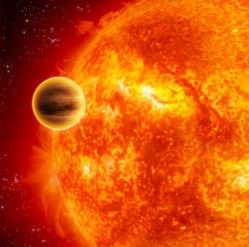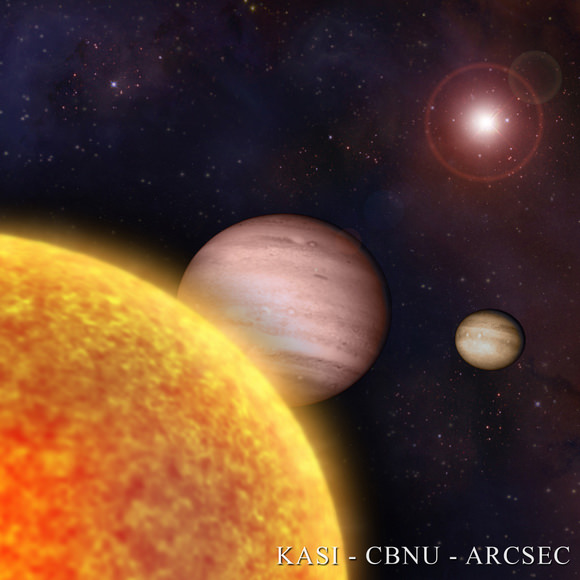[/caption]
Planet hunters from the UK have discovered the largest exoplanet yet, and its uniqueness doesn’t end there. Dubbed WASP-17, this extra large world is twice the size of Jupiter but is super-lightweight, “as dense as expanded polystyrene” one astronomer said. Plus it is going the wrong way around its home sun, making it the first exoplanet known to have a retrograde orbit. As a likely a victim of planetary billiards, astronomers say this unusual planet casts new light on how planetary systems form and evolve.
Astronomers say the planet must have flipped direction after a near miss with another huge “big brother” planet swung it around like a slingshot. “Newly formed solar systems can be violent places,” said graduate student David Anderson, of Keele University. “Our own moon is thought to have been created when a Mars-sized planet collided with the recently formed Earth and threw up a cloud of debris that turned into the moon. A near collision during the early, violent stage of this planetary system could well have caused a gravitational slingshot, flinging WASP-17 into its backwards orbit.”

Though it is only half the mass of Jupiter it is bloated to nearly twice Jupiter’s size.
Astronomers have long wondered why some extra-solar planets are far bigger than expected, and WASP-17 points to the explanation. Scattered into a highly elliptical, retrograde orbit, it would have been subjected to intense tides. Tidal compression and stretching would have heated the gas-giant planet to its current, hugely bloated extent. “This planet is only as dense as expanded polystyrene, seventy times less dense than the planet we’re standing on”, said Coel Hellier, also of Keele University.
WASP-17 is the 17th new exoplanet found by the Wide Area Search for Planets (WASP) consortium of UK universities. The WASP team detected the planet using an array of cameras that monitor hundreds of thousands of stars, searching for small dips in their light when a planet transits in front of them. Geneva Observatory then measured the mass of WASP-17, showing that it was the right mass to be a planet. The WASP-South camera array that led to the discovery of WASP-17 is hosted by the South African Astronomical Observatory.
Source: STFC


Thanks for that great story, Nancy and continued accolades for providing a link to the original paper. While sometimes impossible to find, astrogeeks like myself do like to directly access the full paper to examine the methodology used and how these researchers came to their conclusions. I see it as an educational opportunity for those that wish more details than press releases to the lay public. . Keep up the good work, Tammy.
. Keep up the good work, Tammy.
Btw: the new 2009 paper on the giant, compact galaxies reported on earlier have been posted here: ” # Jon Hanford Says:
August 9th, 2009 at 10:44 am
The new paper has been posted on the STScI website and can be found here: http://hubblesite.org/pubinfo/pdf/2009/24/pdf2.pdf .Time to check this out ” The 29hr spectrum of 1255-0 is presented and analyzed in the paper. Anne, you may want to update this story (as promised) when the paper became available.
” The 29hr spectrum of 1255-0 is presented and analyzed in the paper. Anne, you may want to update this story (as promised) when the paper became available.
It’s good to get some exoplanet news, lately. It seemed like we we in a dry spell for a while. I know planets are still being discovered, but I guess it’s not a much of a story unless there is something unusual.
For me, even the most mundane exoplanet discovery is interesting!
How to “pump up the volume”.
Me two on the links!
If this exoplanet has a retrograde orbit, tidal forces will eventually pull it into the star. That would be an interesting nova-like event, I’m sure.
Well done WASP, think what is in store now that Kepler is up there!
One question just poped to my mind: wouldn’t such a bloated planet, with a mass that is not all that large and orbiting so close to its star (semimajor axis is only 0.051 AU) be losing atmosphere in a perceptible way? Perhaps even forming a sort of cometary tail?
quite possibly. and if you’re correct, friction must also be hastening the poor retrograde orb of polystyrene towards its fiery doom.
I do not understand – how do you decide which way is north in another star system? How do you decide it is the planet orbits in retrograde and not the star revolving retrograde? Is there an extablished convention on this now?
Well, because the “right” way in each star system is defined by the star. At least until some system is found where *all* the planets are retrograde… which is something I hardly think is possible…